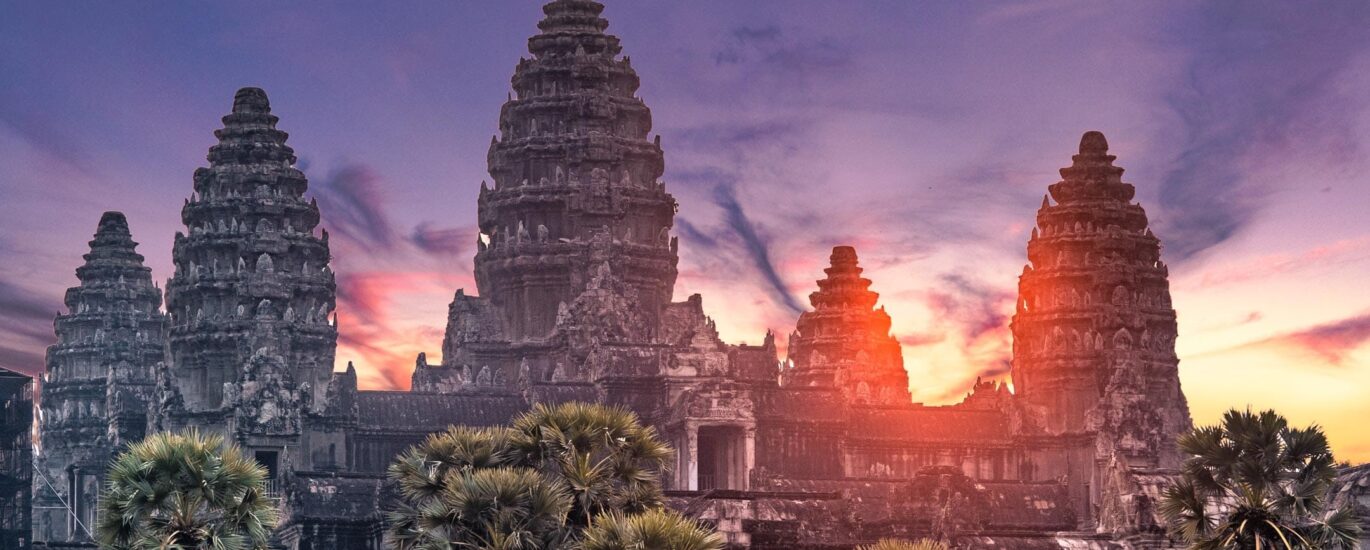When we think of grand Hindu temples, most of us envision magnificent structures in India. However, there exists a temple that stands as the largest Hindu temple in the world, not in India, but in the heart of Southeast Asia – Angkor Wat in Cambodia. This ancient masterpiece is not only the largest Hindu temple but also one of the most awe-inspiring architectural wonders of the world. Let’s dive into the history, grandeur, and cultural significance of Angkor Wat – the biggest Hindu temple in the world.
A Monumental Legacy of the Khmer Empire
Angkor Wat, located in the Siem Reap Province of Cambodia, is the largest religious monument on Earth. It was originally constructed in the early 12th century by the Khmer King Suryavarman II. The temple was dedicated to the Hindu god Vishnu and was designed to represent the mythical Mount Meru, the axis of the universe in Hindu and Buddhist cosmology. Covering an area of over 162 hectares (402 acres), Angkor Wat is an architectural wonder that attracts millions of tourists, historians, and spiritual seekers each year.
From Hinduism to Buddhism
While Angkor Wat was initially a Hindu temple, dedicated to Vishnu, its religious and cultural significance evolved over time. In the late 12th century, the Khmer Empire began to adopt Buddhism, and the temple transitioned into a Buddhist site. Today, Angkor Wat is primarily a Buddhist temple, yet its origins as a Hindu structure remain vital to its identity.
This transformation is a testament to the dynamic nature of the region’s religious and cultural history, where Hinduism and Buddhism coexisted and influenced each other for centuries. Despite the change in religious affiliation, Angkor Wat’s architectural design, including the intricate depictions of Hindu gods and mythologies, continues to preserve its roots in Hinduism.
A Symbol of Hindu Cosmology
Angkor Wat’s architecture is a harmonious blend of art, religion, and science, reflecting the grandeur of Hindu cosmology. The temple’s layout is designed to represent the cosmic world, with the central structure symbolizing Mount Meru, surrounded by walls and moats representing the surrounding mountain ranges and the ocean.
The Main Temple: Central Tower and Layout
The central tower of Angkor Wat rises 65 meters (213 feet) above the ground, representing the summit of Mount Meru, the center of the universe in Hindu mythology. The temple complex itself is a remarkable feat of engineering, built with sandstone transported from a quarry located far from the site.
The entire temple complex is laid out in a rectangular shape, with a series of galleries surrounding the central sanctuary. Visitors walk through the galleries, each with beautifully detailed bas-reliefs depicting scenes from Hindu epics, including the Ramayana and the Mahabharata, as well as the mythical churning of the ocean (Samudra Manthan) and other divine stories.
The Temple’s Iconic Towers
One of the most striking features of Angkor Wat is its five towers, which are designed to resemble the five peaks of Mount Meru. These towers are framed by long, symmetrical walls and covered in exquisite carvings and intricate stonework that tell stories of gods, demons, and heroes.
The detailed carvings in the temple depict Hindu gods and mythological scenes, which include a captivating sequence of gods engaged in celestial battles, dancing apsaras (heavenly nymphs), and more, showcasing the vibrancy and depth of Hindu mythology.
Cultural Significance of Angkor Wat
Angkor Wat is not only significant for its religious history but also for its cultural and national identity. The temple is deeply ingrained in Cambodia’s identity and is featured on the nation’s flag. It stands as a symbol of Cambodia’s glorious past under the Khmer Empire, and its spiritual and architectural brilliance serves as a source of national pride.
Angkor Wat as a Symbol of Khmer Legacy
During the height of the Khmer Empire, Angkor Wat was a political and cultural hub, reflecting the empire’s prosperity, power, and devotion to Hinduism. The construction of Angkor Wat itself was a monumental undertaking, with an estimated 5 million tons of sandstone being used in its creation. This speaks to the architectural mastery of the Khmer people and their profound dedication to their religious practices.
Preserving Khmer Art and Architecture
Apart from its religious role, Angkor Wat also plays a vital role in preserving Khmer art and architecture. The bas-reliefs that cover the temple’s walls serve as important historical records, providing insights into the social, political, and cultural life of the Khmer Empire. The stories depicted on these walls offer a glimpse into the everyday life of ancient Cambodia, from royal processions to battles between gods and demons.
Angkor Wat: A Spiritual Journey and UNESCO World Heritage Site
Angkor Wat is not just a historical landmark but also a deeply spiritual place for both Hindus and Buddhists. Every year, pilgrims from all over the world visit the temple to pray, meditate, and reflect upon its divine presence. It is especially popular during sunrise when the temple’s silhouette is reflected in the water surrounding the site, offering a truly serene and peaceful experience.
As a UNESCO World Heritage Site, Angkor Wat is protected for its cultural and religious significance. Efforts to preserve the temple’s structure and intricate carvings are continually being made to ensure that future generations can experience this incredible landmark.
A Global Attraction
Angkor Wat draws millions of tourists each year, making it one of the most popular destinations in Asia. Its allure goes beyond its status as a Hindu temple; it is a site of immense natural beauty, ancient wisdom, and cultural richness. Tourists come from all over the world to marvel at the temple’s grandeur, learn about its fascinating history, and soak in the spiritual atmosphere.
Angkor Wat is an extraordinary blend of art, history, religion, and architecture, making it the largest Hindu temple in the world. Though it has transformed into a Buddhist site over the centuries, its deep Hindu roots remain intact, showcasing the grandeur of ancient Hindu culture and religion.
This magnificent temple continues to inspire awe and admiration, not only for its sheer size and beauty but also for the rich history it encapsulates. As a symbol of Cambodia’s rich heritage and a beacon of Hindu cosmology, Angkor Wat remains one of the greatest and most significant monuments in the world.









